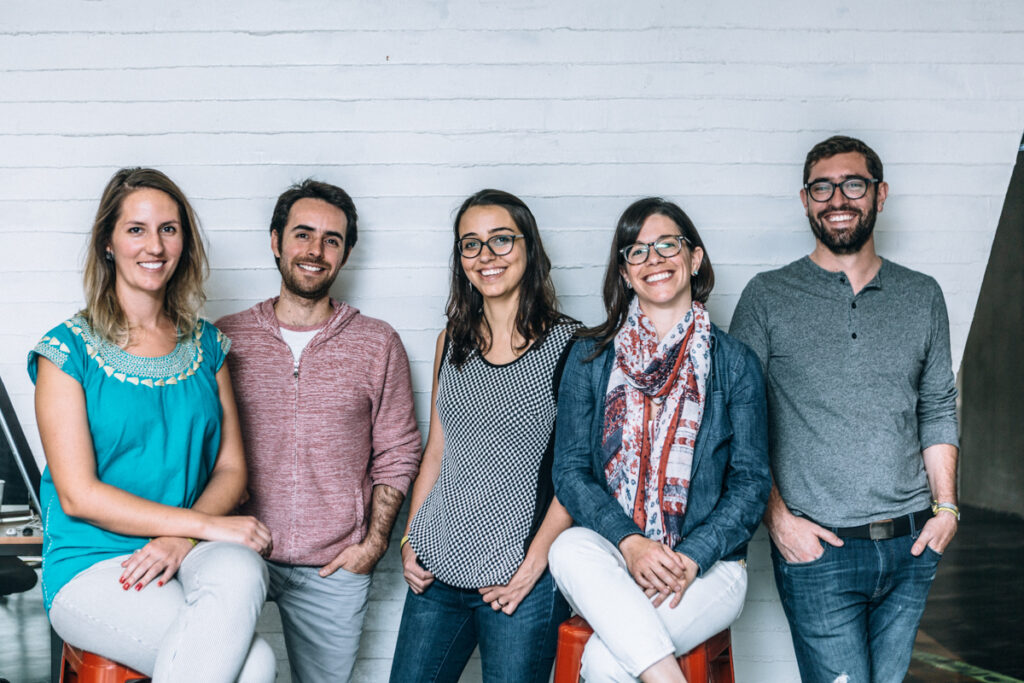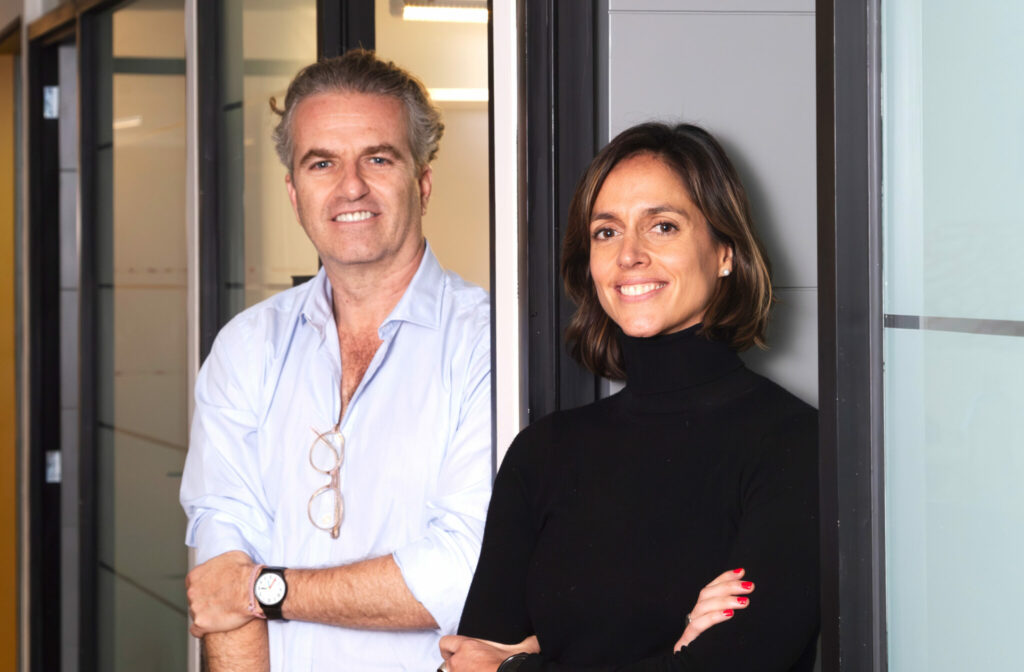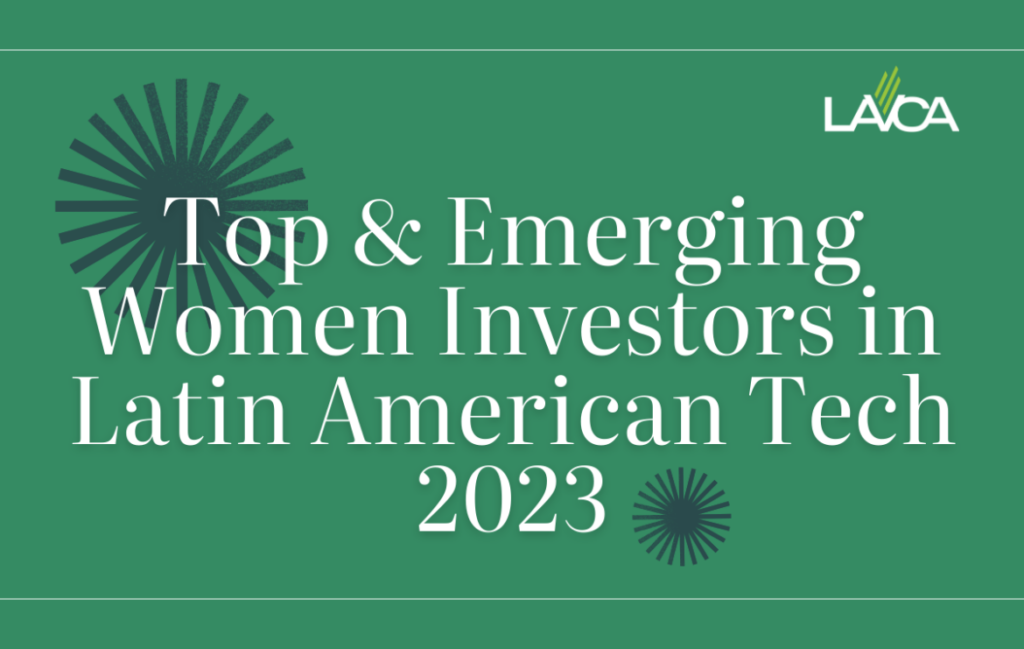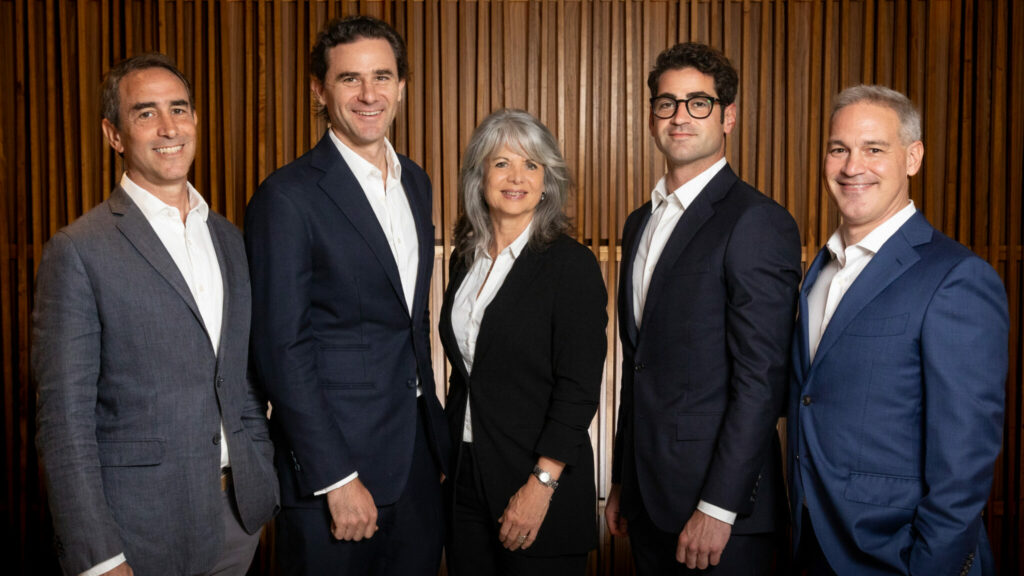Entrepreneur Profiles, Gender Diversity
Peru’s Laboratoria Tackles Coding Gender Gap in Latin America with International Funding
15 November 2017

Company: Laboratoria
Co-Founders: Mariana Costa, Herman Marin, and Rodulfo Prieto
Investors: Omidyar Network, Google, IDB (Inter-American Development Bank)
[transcription]
[english]
Mariana Costa, Herman Marin, and Rodulfo Prieto founded Laboratoria, an organization to teach low-income women in Latin America programming and web development skills. More than 400 female developers from Lima and Arequipa in Peru, Santiago de Chile, and Mexico DF have passed through Laboratoria’s program since 2014; 75% have found jobs, with a 3X average increase in their starting salary. In this interview with Laboratoria co-founder and CEO Mariana Costa—one of the most innovative people in Peru under 35, according to MIT Technology Review—we learn about Laboratoria’s mission to close the coding gender gap and graduate the best tech talent in Latin America.
LAVCA: What is the history of Laboratoria?
Mariana Costa: I started a software development agency in Lima with two partners, one from Venezuela and one from Ecuador. I am Peruvian, but I lived many years abroad. During our experience running the agency, we lived through the difficulty of having to put together our own team of developers.
We built the developer team with a lot of time and effort. They were all male, 13 of the 15 people in the company, and they had not necessarily gone to university. Many of them had studied on their own or had studied something else, or had gone to a little-known university, and that was not an impediment for them to do well in this role. In many other careers, you often need a good diploma and a good school to excel, and here it seemed that it was not a requirement.
This led us to create a social enterprise to focus on training women in this high-demand skill set, since there were so few in the industry.
LAVCA: And why the focus on women?
Mariana Costa: Women are less than 6% of the developers in Peru, and it’s the same in Latin America, and there is an imminent need to change that. Technology is used by men and women. It makes no sense to have only men creating it. If we do not put more women in this industry today, we will be more displaced from the jobs of the future.
Women are less than 6% of the developers in Peru, and it’s the same in Latin America, and there is an imminent need to change that.
LAVCA: What is your approach in terms of training?
Mariana Costa: The program tries to be accessible by building an accountable education system. We do not charge the students for the first part, because they study full-time, but as soon as they get a job, they pay the full amount of the program.
We have a selection process where we invite young women to apply. We try to identify young people with great potential and an interest in technology who have not been able to access good education. Then they pass a series of cognitive tests, other soft skills tests, and an interview.
The program happens in two parts: the first one has a duration of six months and is full-time. We focus on Web Development Front-End, particularly in JavaScript, and also in personal and professional development.
Then we do professional intermediation. We have a series of events where we bring companies of all sectors and sizes that are looking for this kind of talent, and we do a Hackathon so that companies can identify talent. We support our students to negotiate their hiring.
After this, they enter a continuing education program, which lasts a year and a half, and we charge for it on a monthly basis. It is a specialization program: They can become full-stack, UI designers, etc. It’s only four hours per week, online and live.
In addition, we offer other services to employers. They hire Laboratoria talent, but they also hire us to do some training programs with them, set up of technical teams and how to go through this process of digital transformation.
LAVCA: What is the profile of women who are part of Laboratoria?
Mariana Costa: We look for talent where there is a lot of talent, but nobody else has looked for it. In countries such as Peru and Latin America in general, the lack of access to opportunities for young people is enormous. So we look for women who are looking to change their future and have not had the means to do so.
The typical case is a 22-year-old girl who finished high school in a public school, spent a year figuring out what to do, then entered a university or college, but after a few years she had to leave because her mother lost her job, dad got sick…. Then she went to work on whatever she could find without a degree, without a good education, as a cashier in a bank, in a supermarket, in sales or in a call center. The average salary of students of Laboratoria before the program is around $180 per month.
LAVCA: Can you share a success story?
Mariana Costa: We have a lot. We have already graduated more than 400 developers. Right now we are about to graduate almost 200 more, and we have students who work in companies like IBM and Accenture, where they not only have a job, but have started a career and have increased their income five-fold.
LAVCA: How do you fund Laboratoria?
Mariana Costa: At the beginning, it was bootstrap, low-budget. We had the other company, so one developer from the other company was the teacher. We got a classroom. It was very inexpensive, really. And once the pilot finished, and we validated the concept, we placed some of the graduates of that pilot.
After that, we won a Social Enterprise prize, and then we got a grant from the Peruvian Government, from CONCYTEC, the National Council of Science and Technology. Now we have a grant from the IDB (Inter-American Development Bank), and another from Google. One of our investors is Omidyar Network.
LAVCA: Is the fee the same for all of your students?
Mariana Costa: No, it is variable. There is a fixed minimum, but it is set in accordance with their salary when they enter the program.
LAVCA: I know that you’ve had students dropping the program due to particular circumstances – such as relative becoming ill. How have you overcome that challenge?
Mariana Costa: We have increased the level of competence of our students. Moreover, the salary of our students, since we started so far, it has increased by 85% because their technical level is much better. We start with HTML, CSA, very basic JavaScript. Right now, they are front-end developers. They already have a pretty advanced technical level.
LAVCA: So, the process of admission is much more competitive?
Mariana Costa: It’s very competitive right now, yes. It depends on the headquarters, but in Peru, for example, only 10% get accepted. Applicants do not necessarily have to have experience in front-end web development. Rather, we are trying to measure their ability to learn.
LAVCA: What are your expansion plans?
Mariana Costa: Right now, we are in Peru, Chile, and Mexico. We want to open Laboratoria in Brazil.
An important piece of our model is that we really try and aspire to be the best tech talent, regardless of the audience we have. Our value to companies is that this is the best place to find front-end developers, and soon, software developers, UI designers, and back-end developers as well.
LAVCA: You said that Omidyar, the IDB, and Google have been key partners; in what sense?
Mariana Costa: I have always looked for people who not only finance us but who open doors, advise and challenge us…. In this sense, our main funders are IDB, Google, and Omidyar. We have a very close relationship with all of them.
LAVCA: How has Peru’s tech ecosystem advanced?
Mariana Costa: It has advanced a lot. With respect to entrepreneurship, there is more financing, there are more entrepreneurs, there is more talent betting on entrepreneurship. We are an important piece here too because we provide technical talent. Right now, we have graduates placed at the regional level in more than 200 companies. In Peru, we have students working at, easily, 100 companies—many startups, but also large corporations, banks, and retail companies.
LAVCA: In your opinion, what is the biggest challenge that Peru is facing with respect to venture capital?
It has to be a disciplined process, because we want to generate an ecosystem that is fair to both parties. And when financing is scarce, it can generate terms and conditions that are not favorable for the development of the enterprises, and therefore the ecosystem.
Mariana Costa: It’s an ecosystem, and you need several pieces in place for things to work. The entrepreneur and the investor must complement each other as more financing comes into place. And in this case, I believe that the government is beginning to play an interesting role, because it is financing risk that investors still dare not touch, and it is demonstrating the potential of the sector.
I believe that there is a bigger critical mass of very competent and good people who decide to take the risk and build a company and that manage to get the capital. And that makes investors say, “Well, there is something to look at here.”
It has to be a disciplined process, because we want to generate an ecosystem that is fair to both parties. And when financing is scarce, it can generate terms and conditions that are not favorable for the development of the enterprises, and therefore the ecosystem.
[/english]
[spanish]
Mariana Costa, Herman Marin y Rodulfo Prieto fundaron Laboratoria, una organización que enseña programación y desarrollo web a mujeres de bajos ingresos en América Latina. Más de 400 mujeres mujeres de Lima y Arequipa en Perú, Santiago de Chile y México DF han pasado por el programa de Laboratoria desde 2014; el 75% ha encontrado trabajo, con un aumento promedio de 3X en su salario inicial. En esta entrevista con la cofundadora y directora ejecutiva de Laboratoria, Mariana Costa, una de las personas más innovadoras en Perú menores de 35 años, según MIT Technology Review, aprendemos sobre la misión de Laboratoria de cerrar la brecha de género en la programación y graduar al mejor talento tecnológico en América Latina.
LAVCA: Cuéntanos un poco sobre la historia de Laboratoria.
Mariana Costa: Comenzamos una agencia de desarrollo de software, aquí en Lima, yo y dos socios. Yo soy peruana, pero viví muchos años fuera, uno de mis socios venezolano y el otro ecuatoriano. A través de esa experiencia, vimos el reto de tener que armar nuestro propio equipo de developers, era muy difícil encontrar developers.
Formamos el equipo de developers con mucho esfuerzo y tiempo. Cuando lo armamos, eran todos varones – éramos 15 personas, de los cuales 13 eran varones – y no necesariamente habían ido a la universidad – muchos de ellos habían estudiado por su cuenta o habían estudiado otra cosa, o habían ido a una universidad poco conocida, y eso no era un impedimento para que les fuera muy bien laboralmente. En cualquier otra carrera, necesitas un buen diploma y una buena escuela para que te vaya bien, y acá parecía que no era un requisito.
Esto nos llevó a crear un emprendimiento social para enfocarnos en capacitar a mujeres en este skill de alta demanda, ya que había tan pocas en la industria.
LAVCA: ¿Y por qué el enfoque de mujeres?
Mariana Costa: Las mujeres son menos del 6% de los developers aquí, e igual en América Latina, y hay una necesidad inminente de cambiar eso. La tecnología la usamos hombres y mujeres por igual. No tiene ningún sentido que sean solo hombres los que la crean. ¿Dónde van a estar los empleos del futuro? Si no ponemos a más mujeres ahí hoy en día, vamos a quedar más desplazadas de los empleos del futuro.
LAVCA: ¿Cuál es el approach?
Mariana Costa: Es un programa que intenta ser accesible construyendo un sistema de educación accountable. No le cobramos a las estudiantes por la primera parte, porque estudian full-time, pero en cuanto consiguen trabajo, ellas pagan el monto completo del programa.
Tenemos un proceso de selección donde invitamos a las jóvenes a postular. Tratamos de identificar a jóvenes con un gran potencial, con interés en la tecnología pero que no han podido acceder a educación de alto nivel. Luego pasan una serie de pruebas cognitivas, otras pruebas de habilidades blandas, y una entrevista.
El programa tiene dos partes: una primera parte de seis meses, que es full-time. Nos enfocamos en “Web Development Front-End”, en particular en JavaScript, es como el licor del programa, y también en su desarrollo personal y profesional. Luego hacemos la intermediación laboral. Tenemos una serie de eventos, el Talent Fest, donde traemos a empresas de todo tipo y tamaño que están buscando este talento, y hacemos una Hackathon, para que las empresas puedan identificar talento. Y acompañamos a nuestras estudiantes en el proceso de negociación de condiciones con las empresas.
Luego de esto, ellas entran en un programa de educación continua que tenemos, el Lifelong Learning, que dura un año y medio más, por el que pagan ya todos los meses. Es un programa para que vayan especializándose, donde ofrecemos ya tracks, puedes volverte full-stack, pueden ser UI designer, pero son cuatro horas por semana, online y en vivo. Y además, a las empresas empleadoras también les ofrecemos otros servicios. Ellas contratan talento de Laboratoria, pero también nos contratan a nosotros para hacer algunos trainings con ellas, tipo set up de technical teams y cómo pasar por este proceso de transformación digital.
LAVCA: ¡Qué bueno! ¿Cuéntanos sobre el perfil de mujeres que son parte de Laboratoria?
Mariana Costa: Buscamos talento donde hay muchísimo talento, pero nadie más lo ha buscado. En países como el Perú y en general América Latina, la falta de acceso a oportunidades para jóvenes es enorme. Entonces nosotros buscamos a mujeres que estén buscando cambiar su futuro y no han tenido los medios para hacerlo.
El típico caso es una chica de 22 años que terminó el secundario en un colegio público, pasó un año viendo qué hacer, luego entró en alguna universidad o instituto, pero al cabo de unos años lo tuvo que dejar porque la mamá perdió el trabajo, el papá se enfermó… Por alguna circunstancia complicada. Entonces se puso a trabajar en lo que podía encontrar sin un título, sin educación buena, como cajera en un banco, en un supermercado, en ventas o en un call center. El ingreso de estudiantes de Laboratoria antes del programa es de alrededor de 180 dólares al mes.
LAVCA: ¿Puedes compartir algún caso de éxito?
Mariana Costa: Tenemos un montón. Hemos graduado ya a más de 400 developers. Ahorita estamos por graduar a casi 200 más, y tenemos estudiantes que trabajan en compañías como IBM, Accenture, en las que no solo tienen un trabajo, sino que han comenzado una carrera y han quintuplicado sus ingresos.
LAVCA: ¿Cómo empezaron Laboratoria?
Mariana Costa: Al comienzo fue bootstrap, low-budget. Teníamos la otra empresa, entonces un developer de la otra empresa fue el profesor. Conseguimos un salón de clases. Fue muy a bajo costo, en verdad. Y ya una vez que terminó el piloto, y validamos el concepto, colocamos algunas de las egresadas de ese piloto. Primero ganamos un premio de Social Enterprise, y luego conseguimos un grant del Gobierno peruano, del CONCYTEC, el Consejo Nacional de Ciencia y Tecnología. Ahora tenemos un grant del Banco Interamericano de Desarrollo, otro con Google, uno de nuestros inversionistas es Omidyar.
LAVCA: Entonces, ¿cada porcentaje que cobras a los participantes es fijo?
Mariana Costa: No, es variable. Depende de cada quien. Hay un mínimo fijo, pero después hay un variable, dependiendo del salario al momento de ingresar al programa.
LAVCA: He escuchado que algunas participantes tuvieron que dejar de participar de Laboratoria por causa de alguna circunstancia – tipo enfermedad de parientes. ¿Cómo han superado ese desafío?
Mariana Costa: Hemos aumentado el nivel de competencia de nuestras estudiantes. Es más, el salario de nuestras estudiantes, desde que empezamos hasta ahora, ha incrementado un 85% porque su nivel técnico es mucho mejor. Empezamos con HTML, CSA, muy básico JavaScript. Ahorita ya son front-end developers. Ya tienen un nivel bastante avanzado.
LAVCA: ¿Entonces el proceso de postular es mucho más competitivo?
Mariana Costa: Es bien competitivo ahorita, sí. Depende un poco de la sede, pero en Perú, por ejemplo, el 10% ingresa. Pero no necesariamente tienen que tener experiencia en front-end web development. Medimos más bien su capacidad de aprendizaje.
LAVCA: ¿Cuáles son tus planes de expansión?
Mariana Costa: Ahorita estamos en Perú, en Chile y en México. Y luego, vamos a abrir Laboratoria en Brasil.
Creo que algo importante en nuestro modelo es que realmente tratamos y aspiramos a ser el mejor tech talent, independientemente del público que tenemos, nuestro valor hacia las empresas es que este es el mejor lugar donde encontrar — ahorita front-end developers, pronto software developers, UI designers, back-end developers.
LAVCA: Dijiste que, por ejemplo, Omidyar, el Banco Interamericano de Desarrollo han sido clave para ustedes, ¿en qué sentido?
Mariana Costa: Siempre busqué gente que no solo nos financie, pero que también abra puertas, nos dé consejos, nos rete… En ese sentido, nuestros principales financiadores son BID, Google y Omidyar. Con los tres tenemos una relación muy cercana.
LAVCA: ¿Cómo ha avanzado el ecosistema tech de Perú?
Mariana Costa: Ha avanzado un montón. Con respecto al emprendimiento, hay más financiamiento, hay más emprendedores, hay más talento que apuesta por emprender. Yo creo que nosotros somos una pieza importante ahí también, porque proveemos talento técnico. Ahorita tenemos egresadas colocadas a nivel regional en más de 200 empresas. En Perú debemos tener estudiantes trabajando en, fácil, 100 empresas. Muchos startups, pero también grandes clientes corporativos, bancos, empresas de retail, de todo.
LAVCA: ¿En tu opinión, cuál es el desafío más grande que Perú está enfrentando con respecto a Venture Capital?
Mariana Costa: Creo que son varias piezas. Es un ecosistema, y necesitas varias piezas en lugar para que las cosas funcionen. El emprendedor o el que lo financia deben complementarse conforme aparece más financiamiento. Y ahí creo que el Estado está empezando a jugar un rol interesante porque está financiando riesgo que acá los inversionistas todavía no se atreven a tocar, y está demostrando que el potencial del sector.
Ahora, sí creo que hay una masa crítica más importante de gente muy competente y muy buena que decide emprender y decide tomar el riesgo y armar algo y que logra conseguir el capital. Y eso hace que los inversionistas digan: “Bueno, hay algo para mirar acá”.
Tiene que ser un proceso bien educado, porque queremos generar un ecosistema que sea justo para ambas partes. Y cuando el financiamiento es escaso, puede generar términos y condiciones como quieran no favorables para el desarrollo de los emprendimientos, y por ende del ecosistema.
[/spanish]
[portuguese]
This article is not available in Portuguese. Please see English and Spanish versions.
[/portuguese]
[/transcription]
You may be interested in...
-

Is AI a Thing in Latin America? In Conversation with Hi Ventures
LAVCA sits down with Hi Venture to discuss their evolving thesis and vision for...
-

Top & Emerging Women Investors in Latin American Tech 2023
View LAVCA’s list of Top Women Investing In Latin American Tech. Women in venture...
-

The Future of B2B Startup Investing in LatAm: In Conversation with NXTP
NXTP Ventures recently reached a USD98m final close for NXTP Fund III, its third...
-

A 20-Year Journey: An Interview with Technisys CEO Miguel Santos
Company: Technisys Investors: KASZEK, Dalus Capital, Riverwood Capital Interview...